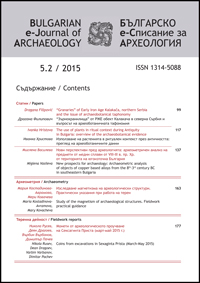“Granaries” of Early Iron Age Kalakača, northern Serbia
and the issue of archaeobotanical taphonomy
“Granaries” of Early Iron Age Kalakača, northern Serbia
and the issue of archaeobotanical taphonomy
Author(s): Dragana FilipovićSubject(s): Archaeology
Published by: Асоциация на българските археолози
Keywords: Early Iron Age; Vojvodina; Kalakača; pit-features; storage; charred plant remains; taphonomy; millet
Summary/Abstract: Archaeological excavations of the Early Iron Age site of Kalakača in northern Serbia revealed the presence of numerous pit-features and traces of several possible above-ground structures. A number of pits were inter¬preted as storage features. Moreover, the charred plant remains in some of them were taken as an evidence of the function of the pits as crop stores/granaries. Archaeobotanical analysis confirmed the presence of a range of crops in the pits; however, the circumstances in which the charred crop remains were found strongly suggest that there is no direct connection between the plant material and the pit-features. No traces of in situ burning were detected in the excavated pits, demonstrating that the charring of plants happened outside. The use of charred plant remains as evidence for the storage of crops in the Kalakača pits can thus be dismissed. The plant material was perhaps charred within the surface structures. The analysis of the type of plant parts re-deposited in the pits reveals the presence of crop products – chiefly millet grain (most likely semi-cleaned) and some barley grain; and crop processing by-products – wheat and barley chaff. Millet grain may have originated from millet stores; cereal chaff may have arrived in the pits as daub temper or as crop processing residue discarded in fire.
Journal: Българско е-Списание за Археология
- Issue Year: 5/2015
- Issue No: 2
- Page Range: 99-115
- Page Count: 17
- Language: English

